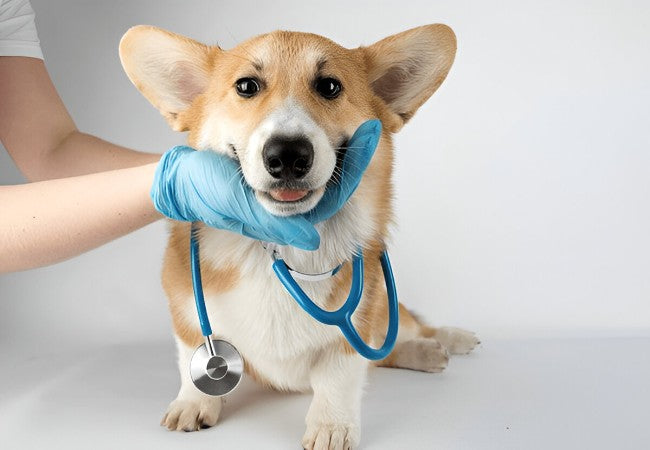Veterinary Guide to Canine Hypothyroidism 2025 🩺🐶

In this article
Veterinary Guide to Canine Hypothyroidism 2025 🩺🐶
By Dr. Duncan Houston BVSc
🧬 What Is Hypothyroidism in Dogs?
Hypothyroidism in dogs is a common endocrine disorder caused by insufficient thyroid hormone production, leading to a slowed metabolism. The thyroid glands are located on either side of the neck, and their reduced output affects many body systems, causing skin issues, weight gain, lethargy, and more.
📌 Primary vs Secondary Hypothyroidism
- Primary: Most cases (≥95%) due to lymphocytic thyroiditis (immune‑mediated) or idiopathic atrophy of thyroid glands.
- Secondary/Tertiary: Rare causes include pituitary or hypothalamic dysfunction leading to decreased TSH or TRH.
👥 Risk Factors & Breed Predisposition
- Middle‑aged dogs (4–10 years) are most commonly affected—average age ~6–7 years.
- No strong sex predisposition—but spayed females and neutered males may be at slightly higher risk.
- Breeds predisposed: Golden Retrievers, Dobermans, Dachshunds, Miniature Schnauzers, Cocker Spaniels, Irish Setters, Boxers, English Setters, Giant Schnauzers, Beagles.
👀 Clinical Signs
Thyroid hormones regulate metabolism, skin, neurologic, and cardiovascular function. Common signs include:
- Weight gain despite normal or decreased appetite.
- Lethargy, exercise intolerance, depression.
- Cold intolerance—dogs often seek warmth.
- Skin issues: alopecia (symmetrical), hyperpigmentation, seborrhea, chronic otitis, pyoderma.
- Dry, dull hair coat and poor regrowth.
- Hypercholesterolemia or hypertriglyceridemia on lab tests (~75% cases).
- Bradycardia, mild arrhythmias; myxedema (“tragic face”) in advanced cases.
- Occasional neurologic signs—megaesophagus, vestibular dysfunction, neuropathy.
- Rare severe presentation: myxedema coma—life‑threatening emergency.
🔬 Diagnostic Workflow
- History & physical exam: note obesity, coat changes, ear infections, behavior shifts.
- Baseline bloodwork: CBC, chemistry, lipid profile; expect hyperlipidemia and mild anemia.
-
Thyroid panel:
- Low total T4 is screening; confirm with free T4 (fT4) and TSH. Primary hypothyroidism: ↓T4/fT4 with ↑TSH.
- Avoid testing during illness (euthyroid sick syndrome) or when on medications affecting thyroid function.
- Advanced tests: Thyroid autoantibodies (lymphocytic thyroiditis); imaging (rare for tumor).
- Differentials: Rule out Cushing’s, diabetes, heart disease, and neurologic causes.
🛠️ Treatment
💊 Lifelong Levothyroxine Replacement
- Synthetic levothyroxine sodium; FDA-approved options include Thyro‑Tabs and ThyroKare®.
- Typical starting dose: 0.02 mg/kg once or twice daily—administer consistently with or without food.
- Adjust dosage based on recheck labs (4–8 weeks after starting), then every 6–12 months once stable.
- Expect energy improvement in 1–2 weeks; skin/monthly hair regrowth in 4–8 weeks; coat health over 3–4 months.
⚠️ Monitoring & Avoiding Overtreatment
- Over-supplementation can cause iatrogenic hyperthyroidism: restlessness, polyuria, tachycardia, weight loss.
- Monitor thyroid values 4–8 weeks after dosage changes and periodically thereafter.
- Be cautious with concurrent diseases (heart disease, Addison’s, diabetes)—coordinate treatment plans.
🩺 Addressing Concurrent Issues
- Skin infections may require antibiotics or medicated shampoos.
- Arthritis/pain from weight gain may need NSAIDs, weight management.
- Neurologic signs may need additional diagnostics (e.g., megaesophagus).
⌛ Prognosis & Long-Term Management
- Treated dogs have a normal lifespan and quality of life.
- The prognosis is poor for congenital cases and myxedema coma.
- Annual rechecks recommended; more frequent if dose adjustments or illness occur.
- Owners should monitor energy, weight, coat, appetite, and cardiovascular signs.
🏡 Owner & Lifestyle Support
- Feed a balanced diet—adjust calories to maintain a healthy weight.
- Keep a consistent medication schedule; use pill organizers or reminders.
- Monitor for signs of overtreatment or recurrent symptoms.
- Ensure safe exercise—avoid overexertion during dose adjustment.
- Maintain grooming, skin checks, and regular vet visits.
📱 Ask A Vet Telehealth Integration
- Virtual consults: Upload exam photos (coat, weight, behavior) to adjust therapy remotely.
- Medication reminders: Custom alerts for dosing schedule and recheck labs.
- Follow-up notifications: Prompt owners for thyroid panel checkups.
🎓 Case Spotlight: “Jake” the Golden Retriever
Jake, a 7‑year‑old Golden Retriever, presented with weight gain, lethargy, and recurrent ear infections. Blood tests showed low T4, high TSH. He began levothyroxine twice daily—within two weeks, energy improved; within two months, his weight normalized, and ear issues resolved. His coat regrew fully by four months, and he now enjoys annual remote follow-ups via Ask A Vet. 🐕🎉
🔚 Key Takeaways
- Hypothyroidism is common and treatable, but requires lifelong management.
- Watch for slow signs: weight gain, lethargy, skin/coat changes.
- Diagnosis requires careful blood panels—avoid testing during illness.
- Levothyroxine therapy is effective with routine monitoring.
- Owners and Ask A Vet teamwork ensure happy, healthy outcomes. 🧡
Dr Duncan Houston BVSc, Ask A Vet founder. Download the Ask A Vet app today for expert remote management of your dog’s thyroid health—nutrition guidance, dosing reminders, and regular check-ins keep your pup thriving! 🐶📲






